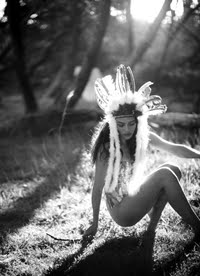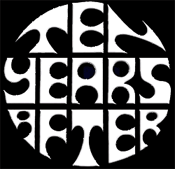
The Standells were thee punk band of the 1960s. They combined a snarly, moody look with a vicious, burning sound that made them the epitome of Teenage Punk. Their records were a tour de force of us-versus-them teenage stances packed into two-and-a-half minute, commercial rock songs. It all worked so well, that it seems amazing such a group could have emerged from their rather ordinary backgrounds.
Earlier in the decade the Standells -- Larry Tamblyn, Tony Valentino, Gary Lane and Gary Leeds (who was replaced by Dick Dodd in 1963) -- were a clean-living, fun bunch of bananas who layed down the rock hits of the day. like "Louie Louie" and "Money" at trendy clubs like P.J's and on a variety of TV shows like the "Munsters" and movies like "Zebra in the Kitchen" where a clean rock'n'roll band was needed. The group included one guy who spoke in a very unhip, broken Italian accent, and another who was a refugee from the Mouseketeers. After a few recordings of minor notes, their fortunes changed upon meeting producer/songwriter Ed Cobb. The match was perfect. Ed was formerly a member of the super clean Four Preps!
Rather than a combined future in a Disneyland-like middle American Heaven, Ed and the boys pulled a Dr. Jekyll/Mr. Hyde and bounded back with a very seething, resentful, provoking approach that was very influenced by the Rolling Stones. Perhaps the years of growing up squeeky clean had supressed a lot of angst that unleashed itself in the group's newfound personality.
"Dirty Water" was released as a single on Capitol Records' Tower subsidiary towards the end of 1965, not because there was any great belief in the record, but because Tower really wanted a Ketty Lester record that Cobb also produced. In July, 1966, "Dirty Water" surprised everybody climbing to number 11 on Billboard's national chart.
Cobb wrote the song from an experience he had while walking with his girlfriend along the river -- and thwarting off muggers -- in Boston. This led to the Standells opening up for the Rolling Stones on the latter's U.S. tour. "Sometimes Good Guys Don't Wear White" was the next hit. An emitted saga of just-because-I'm-poor-doesn't-mean-I'm-not-as-good-as-you, the tone of the group rendered their appeal somewhat suspect: "If you think those guys in the white collars are better than I am baby, flake off! You don't dig this long hair, get yourself a crewcut!" The stance was one of feigned sympathy.
Other songs cemented image. The chip-on-the-shoulder bad boys, despite having a tough go of life -- still manage to indulge in their pleasure of loose women ("Medication") and drugs. And to actually sing about spending the night in jail (an Ed Cobb song, again, from a personal, cops-versus-hippies experience), in an era a year away from the Rolling Stones' shattering drug busts, was further evidence that the Standells were the equivalence of a menacing, musical street gang. In spirit, a true American counterpart to the Rolling Stones. The Standells were later attracted to the same mysterious Eastern images that the Stones popularized with such songs as "Paint It Black."
This culminated in, perhaps, their finest record, "Try It." An immediate hit in Los Angeles, it was soon banned by most radio stations on the ridiculous notion that its urging to "try it" was a too blatant request for a girl to surrender her virginity. The group even attempted to do battle on the "Art Linkletter Show" in a confusing debate. It was all in vain at the time; although an inferior versions by the Ohio Express made the charts many months later. The next single, "Riot on Sunset Strip," was the title song to the movie of the same name. The Standells appear in the movie along with the Chocolate Watch Band.
When these two remarkable records failed to become national hits, bewilderment set in and the group started to question the direction that they had been so successful at. They rejected Cobb's "Tainted Love," which he later recorded with Gloria Jones, and which became one of the biggest hits of 1982 as recorded by Soft Cell. Their attempt at Stax-influenced soul, "Can't Help But Love You," wasn't entirely convincing. "All Fall Down," included here, bears an uncanny resemblance to Pink Floyd's "Set the Controls for the Heart of the Sun." While this foray into psychedelia was indeed a novel one for the Standells, it seems a mere coincidence that their's and Pink Floyd's were released roughly the same time, both on Tower. "Animal Girl" was the group's last single. Again, uncharacteristic, it's a gently melodic, evocative song that expresses the honest, spontaneous quality of a girl. Ritchie Polodor, who engineered the session, plays the sitar.
The end of the 1960s ushered in a whole new era of Woodstockian-like heavy, progressive, jamming bands that rendered a "Serious" group like the Standells impotent. They were lost in a new era of 1000 watt Marshalls and twenty minute guitar solos. That confusion coupled with a lack of direction and internal difficulties splintered the band.
The Standells' influence remains strong in the 1980s. The Inmates rediscovered "Dirty Water" and had a hit with their own version of the song. There's a wealth of current punk bands with names like the Unclaimed, Chesterfield Kings, Barracudas, Pandoras and more who either perform Standells songs, or are in other ways quite clearly influenced by them. When it comes to '60s punk, the Standells were the best.
With the demise of the Standells, it seems as if punk died too. It took almost ten years for punk to return with the Sex Pistols, Ramones and others, all of whom invariably acknowledged the Standells as a prime inspiration.
Personnel notes: The Standells as we know them boasted a consistent core of Dodd, Valentino and Tamblyn. Previous to Dodd joining, Gary Leeds played drums, but left to form the Walker Brothers. Also, not too long after "Dirty Water" had been recorded, and before it started its struggle up the charts, Dodd left the group for four months, and was replaced by Dewey Martin, who later helped form Buffalo Springfield. Gary Lane, their short-haired bass player on the "Dirty Water" LP, left the Standells high and dry during a Florida tour. He was immediately replaced by a dark-haired local boy, Dave Burke, who is pictured on the "Good Guys" and "Hot Ones" covers. Blond John Fleck (nee Fleckenstein) replaced Burke and graced the cover of "Try It". Previously, Fleckenstein was credited as one of the composers of Love's "Can't Explain." As of the last few years he's become a top cinematographer (with "Jaws" among his credits).
Harold Bronson, from the liner notes of The Best of Standells (R2 70176, Rhino, 1989, CD)






















































































2 comments:
Thanks for the liner notes and reminding me how lucky I was for growing up in L. A. Seeing Big Brother and the Holding company playing in our local park is one memory I'.ll always have. Thank you.
What a score! I've had "Dirty Water" playing in my head since I got back from the East coast. Thanks punches for helping me satisfy the urge. Stop by sometime:
http://pettyvendetta.blogspot.com
Post a Comment